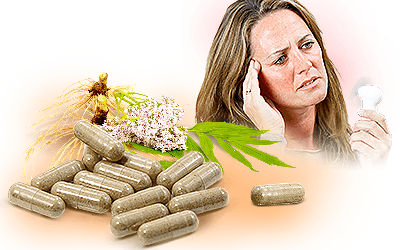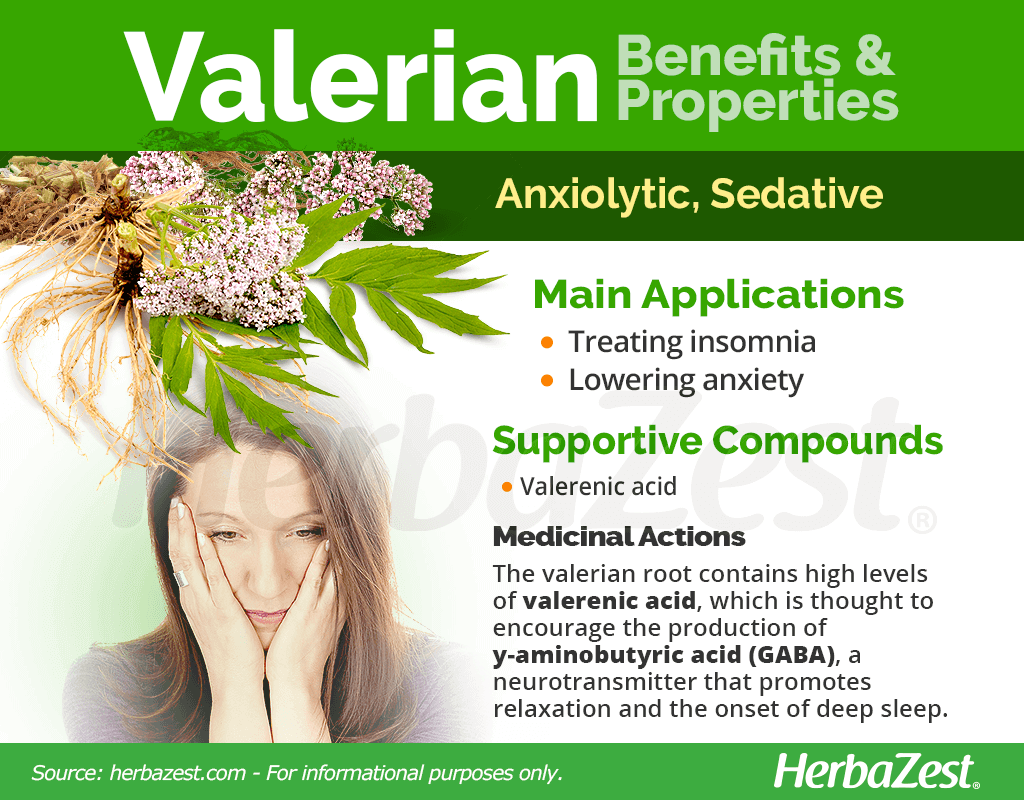Valerian, also known as all-heal, baldrian, cat's valerian, common valerian, and vandal root, among many other names, is one of the most popular medicinal herbs worldwide. Its pungent smell and soothing abilities have turned this Eastern Europe native into one of the household names of Western herbalism. Extensive scientific research on valerian properties has helped identify the origin and full scope of its sedative action, as well as other potential applications.
Valerian Medicinal Properties
Health Benefits of Valerian
Valerian health benefits are mainly anxiolytic and sedative, and have been reaped in medicinal forms for centuries. Modern research has proventhe usefulness of valerian for:
Treating insomnia. Studies have shown that valerian root compounds work on the brain and nervous system, promoting relaxation and inducing sleep.
Lowering anxiety. Valerian's sedative properties help relieve the symptoms of anxiety.
It has also been shown that valerian may relieve hot flashes during menopause, and the herb has been suggested as an alternative treatment for women who are reluctant to receive hormone therapy.
Additionally, although further studies are necessary to fully understand its mechanisms of action, valerian root has been suggested to possess anti-inflammatory properties.
How It Works
The chemical composition of the valerian plant has been intensely studied, although much debate still exists about the mechanisms behind valerian medicinal properties. The main bioactive compounds found in Valeriana officinalis are alkaloids, iridoids, flavanones, and sesquiterpenes.
Valerenic acid is a sesquiterpene responsible for the peculiar smell of valerian herb and, in combination with its derivatives (mainly hydroxyvalerenic acid), is believed to be primarily responsible for the well-known sedative effects of the valerian root. Valerenic acid is thought to interact directly with receptors in the central nervous system (CNS) that handle the production of γ-aminobutyric acid (GABA), a neurotransmitter that promotes relaxation and the onset of deep sleep.
Additionally, the iridoids and alkaloids present in the valerian root seem to inhibit inflammatory processes.
The valerian plant contains phytoestrogens, which have proven effective in the treatment of hot flashes during menopause.
Mild sedative properties can also be found in herbs like chamomile, lavender, lemon balm, linden, rhodiola, and passion flower.
Valerian Side Effects
Valerian root is likely safe for most people in medicinal forms. However, the consumption of valerian root may cause mild side effects, including headache, excitability, uneasiness, and insomnia in rare cases.
Cautions
Individuals scheduled for surgery should avoid consuming valerian root, since it may increase the sedative effect of anesthetics.
Because of its sedative properties, driving or operating heavy machinery after taking valerian root is not recommended.
Valerian may negatively interact with anxiolytic and sedative drugs. If taking prescription medication for anxiety or depression, medical advice is necessary before consuming any medicinal form of valerian.
Due to its potent sedative effects, valerian root should not be taken with St. John's wort, kava kava, L-Tryptophan, or alcohol.
While it is possibly safe for medicinal use, women who are pregnant or breastfeeding should consult a trusted medical professional before consuming valerian in medicinal amounts.
- Medicinal action Anxiolytic, Sedative
- Key constituents Valerenic acid
- Ways to use Capsules, Hot infusions/tisanes, Liquid extracts, Tincture
- Medicinal rating (3) Reasonably useful plant
- Safety ranking Use with caution
How to Consume Valerian
The valerian flower possess a sweet, pleasant fragrance; however, the harvested parts are the roots, which have a strong scent that makes them mostly unsuitable for culinary purposes. Instead, the most effective way of obtaining valerian health benefits is in medicinal forms of consumption.
Natural Forms
Dried. The dried valerian root can be used into medicinal preparations, alone or mixed with similar herbs.
Infusion. Brewing valerian into a warm herbal tisane is a fairly popular method of consumption for treating insomnia and anxiety.
The dried valerian root is a popular alternative for catnip, since felines enjoy its pungent scent.
Herbal Remedies & Supplements
Tincture. This is a concentrated preparation that needs to be diluted in warm water before being consumed, in order to reduce anxiety and induce sleep.
Capsules. Because of its strong smell, valerian root capsules are one of the most palatable ways of consuming the herb in order to reduce anxiety.
- Edible parts Root
- Taste Pungent

Growing
Valerian is an herbaceous perennial, a hardy plant that can be grown in a variety of conditions. Although it is commonly found growing naturally in swamps and marshlands, it prefers tempered climates and requires some basic care in order to thrive.
Growing Guidelines
The valerian plant does well in most types of soil. However, it thrives best in rich, heavy loam soils with plenty of water.
While valerian plants can be grown from seeds, its cultivation is best done through cuttings, planted fully-grown after the last frost of winter.
Under right conditions, germination usually takes place within three months, before temperatures reach55 - 86°F (12 - 30°C), under plenty of natural sunlight.
If growing valerian from seeds, these should be planted one to two feet (30 to 60 cm) apart.
Placing manure on the soil before valerian is planted is the best way to ensure this herb will thrive.
It is important to weed around the valerian plant as it is growing.
Valerian is typically harvested in autumn, during September or October.
Valerian blossoms should be clipped if planning to harvest the roots for medicinal purposes, in order for the nutrients to be concentrated at a single point.
- Life cycle Annual
- Harvested parts Roots
- Light requirements Full sun, Partial shade
- Soil Medium (loam)
- Soil pH 6.1 – 6.5 (Slightly acidic), 6.6 – 7.3 (Neutral)
- Growing habitat Swamps and marshlands
- USDA Plant Hardiness Zones 3a, 3b, 4a, 4b, 5a, 5b, 6a, 6b, 7a, 7b, 8a, 8b, 9a, 9b
- Propagation techniques Cuttings
- Potential diseases Root rot
Additional Information
Plant Biology
The valerian plant (Valeriana officinalis) grows up to four feet (1.2 m) tall and features divided pinnate leaves. When naturally occurring or allowed in cultivation, the valerian flower have a surprisingly sweet scent and are often pale-white, ivory-white, or slightly pink in hue, although they can be peach colored with pink tips. The highest concentrations of active ingredients, however, can be found in the valerian roots, which are known by its distinctive smell.
Classification
Valerian is the best-known member of the Valerianaceae family, which covers 350 species of herbaceous plants that are known for giving off a strong scent.
Varieties and Subspecies of Valerian
Valeriana officinalis is divided into three subspecies: ssp. officinalis, ssp. sambucifolia, and ssp. tenuifolia. Other members of the genus may be commonly confused, but only V. officinalis, better known as baldrian, common valerian, garden valerian, or vandal root, is consumed for medicinal purposes on a large scale. Western valerian (V. occidentalis) is thought to have similar abilities, though there is insufficient research to support this claim. Alpine valerian (V. celtica) was previously used in western Asia to scent perfumes, but it is not meant for ingestion. Native to North America, Sitka valerian (V. sitchensis) is similarly inedible, despite its widespread growth as a ground cover plant.
Historical Information
Archeological findings has traced the history of valerian back to the Bronze Age. According to written records, valerian has been used medicinally since the time of ancient Greece and Rome.
Hippocrates, an ancient Greek physician, described valerian medicinal properties and Galen later described it as a cure for insomnia. Despite falling out of favor in the 19th century, valerian consumption was revived during World War II, as it was used to calm soldiers in high-stress situations.
Valerian was used medicinally in many different cultures, including the Anglo-Saxons and the ancient Arabs.
Popular Beliefs
In medieval Sweden, the valerian plant was sometimes placed in wedding gowns to ward of the envy of elves.
Economic Data
Thanks to significant global interest in valerian supplements the herb now is cultivated at large-scale in its native regions and abroad. Recent data is not widely available, but United Nations statistics from 1998 valued valerian trading in the United States at 8 million USD , with exponential growth predicted in the coming years.
The United States leads the global production of valerian, followed by Germany, the Netherlands, and Bulgaria.
Other Uses of Valerian
Cat's relaxant. The valerian herb can be used as an alternative to catnip (Nepeta cataria) for cats.
Vermin trap. Some reports list attracting rats as one of the possible uses for valerian, as the roots make good bait for traps in areas of infestation.
Antifungal agent. Valerian root can also be used to control the growth of many types of slime molds, since it has the ability of absorbing invasive fungi to forestall their spread.
Sources
- American Herbal Products Association's Botanical Safety Handbook, pp. 910-912
- CRC World Dictionary of Plant Names, p. 2774
- Historical Common Names of Great Plains Plants, p. 434
- Iranian Journal of Phamaceutical Research, The Effects of Valerian Root on Hot Flashes in Menopausal Women, 2013
- The Health Professional's Guide to Popular Dietary Supplements, p. 510
- Edible and Medicinal Plants of the Rockies, p. 225
- USDA Plants Database, Valeriana officinalis L.
- Encyclopedia of Herbal Medicine, p. 148
- MedlinePlus Herbs and Supplements, Valerian
- NCCAM Herbs at a Glance, Valerian
- Encyclopedia of Natural Medicine, pp. 607-608
- Medicinal Plants of the World, p. 335
- Encyclopedia Britannica Online, Valerian (biochemistry)
- New York University - Langone Medical Center, Valerian











